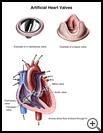
Surgical Valvuloplasty
________________________________________________________________________
KEY POINTS
- Surgical valvuloplasty is surgery to repair 1 or more valves in your heart. Heart valves direct the flow of blood through the chambers of the heart and to the rest of the body.
- This surgery is done only when medicines or other procedures to open or repair your heart valve will not work. Valvuloplasty may be done instead of the surgery that replaces the valve. If you are very sick, it may be done to help you until you are healthy enough to have valve replacement surgery.
- Ask your provider how long it will take to recover and how to take care of yourself at home.
- Make sure you know what symptoms or problems you should watch for and what to do if you have them.
________________________________________________________________________
What is surgical valvuloplasty?
Surgical valvuloplasty is surgery to repair 1 or more valves in your heart. Heart valves direct the flow of blood through the chambers of the heart and to the rest of the body. Valves that don't work right make your heart work harder.
When is it used?
The surgery may be done when a valve in your heart does not open or close all the way. This surgery is done only when medicines or other procedures to open or repair your heart valve will not work.
Valvuloplasty may be done instead of the surgery that replaces the valve. If you are very sick, it may be done to help you until you are healthy enough to have valve replacement surgery.
How do I prepare for this procedure?
- Make plans for your care and recovery after you have the procedure. Find someone to give you a ride home after the procedure. Allow for time to rest and try to find other people to help with your day-to-day tasks while you recover.
- You may or may not need to take your regular medicines the day of the procedure. Tell your healthcare provider about all medicines and supplements that you take. Some products may increase your risk of side effects. Ask your healthcare provider if you need to avoid taking any medicine or supplements before the procedure.
- Tell your healthcare provider if you have any food, medicine, or other allergies such as latex, contrast dye, or shellfish.
- Your healthcare provider will tell you when to stop eating and drinking before the procedure. This helps to keep you from vomiting during the procedure.
- Follow your provider's instructions about not smoking before and after the procedure. Smokers may have more breathing problems during the procedure and heal more slowly. It’s best to quit 6 to 8 weeks before surgery.
- Follow any other instructions your healthcare provider gives you.
- Ask any questions you have before the procedure. You should understand what your healthcare provider is going to do. You have the right to make decisions about your healthcare and to give permission for any tests or procedures.
What happens during the procedure?
The procedure is done in a hospital. You will be given a general anesthetic to keep you from feeling pain. General anesthesia relaxes your muscles and puts you into a deep sleep.
Your healthcare provider will make a cut in your chest and divide your breastbone to open your chest. You will be connected to a heart-lung machine, which will take over the work of your heart and lungs during the surgery. Your provider will then stop your heart, make a cut in your heart to reach the valve, and repair the valve. Your healthcare provider will close the cut in your heart and restart your heart. Your provider will then wire your breastbone together and close the skin with stitches. Some tubes will be left in your chest to drain blood and fluid.
If you have the procedure using a catheter, your healthcare provider will put a catheter through a vein in your groin or through a cut made between two ribs. X-rays and contrast dye injected through the catheter may be used to help show where the catheter is as your provider moves the catheter to repair the heart valve. The catheter and balloon are removed.
What happens after the procedure?
You will be in the intensive care unit (ICU) for the first few days. You may then go to a regular hospital room for a few more days.
Also ask your healthcare provider:
- How long it will take to recover
- If there are activities you should avoid and when you can return to your normal activities
- How to take care of yourself at home
- What symptoms or problems you should watch for and what to do if you have them
Make sure you know when you should come back for a checkup. Keep all appointments for provider visits or tests.
What are the risks of this procedure?
Every procedure or treatment has risks. Some possible risks of this procedure include:
- You may have problems with anesthesia.
- You may have infection, bleeding, or blood clots.
- Other parts of your body may be injured during the procedure.
Ask your healthcare provider how these risks apply to you. Be sure to discuss any other questions or concerns that you may have.

